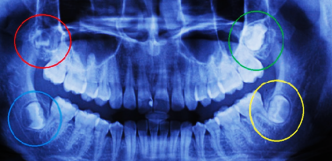
18 May FACTORS AND MECHANISMS IN IMPACTION OF WISDOM TEETH
As the food chain changed in human evolution, the human maxilla went through obvious degeneration, but the number and size of teeth within the jaw did not change. As the maxilla and maxillary dentition occlude with the mandibular dentition, the mandibular teeth are constrained by the maxillary teeth; in the meantime, the maxillary teeth limit the mandibular expansion and lateral growth. Therefore, the maxillary teeth/bone mass ratio is less than the mandibular teeth/bone mass ratio. However, the impaction rate of the wisdom tooth in the upper jaw is far less than that in the mandible.
Three Factors Affecting Wisdom Tooth Impaction
Wisdom teeth are the last ones to erupt into the dentition, and they grow in the “surplus space,” which is often not enough due to the degradation of the jaw and growth restriction as well as the limited space available. Therefore, the wisdom teeth are often impacted during the eruption. There are three main factors influencing the wisdom tooth impaction: space available anterior to the wisdom tooth, the inclination angle of the wisdom tooth, and space available behind the second molar. Among these, the first two are the main factors influencing the impaction of the upper wisdom tooth
Space Available Behind Second Molar Space
The space behind the second molar is defined as the width from the height of the contour of the second molar to the mandibular ramus.

Inclination Angle of Wisdom Tooth
It is the angle between the long axis of the wisdom tooth and that of the second molar

Space Available in Front of the Wisdom Tooth
Even if the space available behind the second molar is wider than the width of the wisdom tooth crown and the inclination angle of the wisdom tooth is less than 26°, the wisdom tooth cannot erupt normally. Lack of the space available in front of the wisdom tooth is one of the reasons causing wisdom tooth impaction

Mechanism of Forming Wisdom Tooth Impaction
Each tooth can accomplish the process of the normal eruption when there is enough space within the jaw. Wisdom teeth are the last ones that erupt into the dentition, and they grow in the “surplus space,” which is often not enough. Therefore, wisdom teeth are often impacted in the process of eruption. The lack of space is the result of a variety of complex factors.
The Overbite of Maxillary Anterior Restricts the Forward Growth of the Mandible
The maxillary dental arch that erupted over the maxillary alveolar ridge occludes with mandibular dentition with a buccal and labial overbite, which restricts the dental alignment over the mandibular alveolar ridge.

Influence of Angle Classification on Posterior Space of Second Molar
Three angle classifications are closely related to the available space posterior to the mandibular second molar. The establishment of the occlusal relationship in early childhood determines how much space is available behind the second molars. As a result, the available space posterior to the second molars has an impact on the rate of normal wisdom tooth eruption.

Effect of Mandibular Ramus Angle on Retromolar Space
The retromolar space is measured by the straight-line distance between the distal height of the contour of the second molar crown and the front edge of the mandibular ramus. The distal height of the contour of the second molar crown is the anterior wall of the retromolar space, and the front edge of the mandibular ramus is the posterior wall of the retromolar space. The retromolar space is the space available for wisdom tooth growth and eruption. The wisdom tooth germ is produced in the lower back of this gap, developing, growing, and erupting forward and upward. Thus, the front edge of the mandibular ramus is closely related to the wisdom teeth

Conclusion
Wisdom teeth are impacted due to the space limitation, size of the jaw, and the resistance of the surrounding tissues. The angle of impactions can be vertical, horizontal, inclined, buccal, lingual, inverse, or reversed. The impacted third molar can be partially erupted or fully embedded. The impaction doesn’t only concern the wisdom tooth but also the adjacent and the occluding tooth. The impacted wisdom teeth may worsen the crowding of teeth. Infections may arise due to poor access to proper cleaning. If the disease persists as a consequence of neglecting the earlier signs and symptoms such as pain, the problems may escalate resulting in possible difficulty in chewing, swallowing, and speaking. Therefore, it is recommended to visit the dentist to check the wisdom teeth starting at the age of 18 to prevent complications caused by the impactions of third molars.



